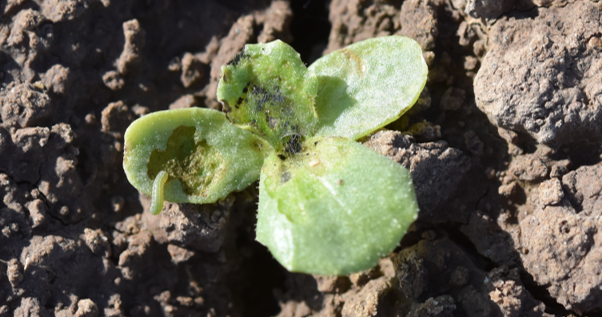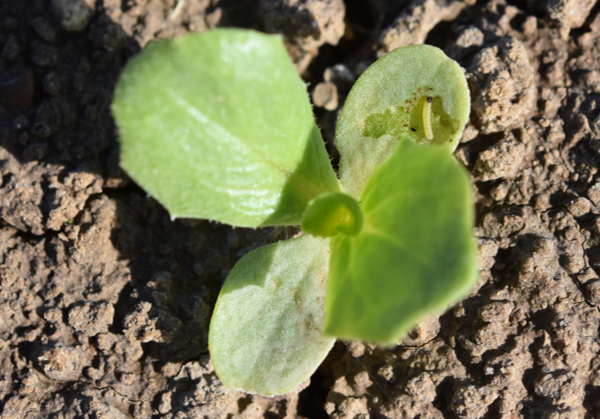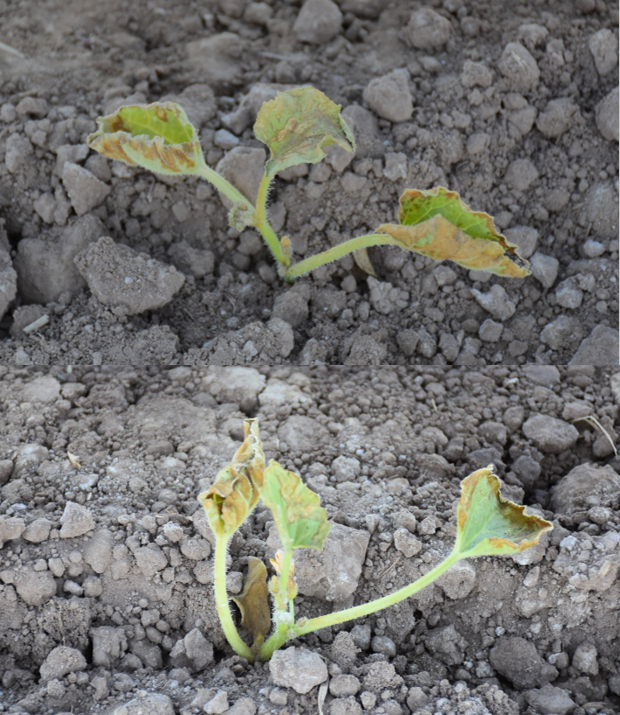
|
|
|
|

|
|||
|
|
|||
In the past few days Over the past 15 years, UA Lettuce Insect Losses Surveys have clearly showed that Lepidopterous larvae (worms) including beet armyworm, cabbage looper, and corn earworm are the most important pests of desert produce during September-November. So far this year worm pressure appears to be about normal, although intensity has varied in many areas. At the Yuma Ag Center, beet armyworm was heavy in early September but has declined slightly in the past week with the cooler temperatures. PCAs were reporting earlier that armyworm were infesting lettuce as soon as 8 days after wet date, but that also has slowed a bit. Cabbage looper larvae have been showing up for a while in low levels and remain light on the Ag Center. Similarly, corn earworm has been reported throughout the area on lettuce and cole crops. These Lep larval numbers have been consistent with adult trap catches which have been about average for this time of the year (see Areawide Insect Trapping Network). Following the storms last week, trap catches of armyworm, loopers, and earworm were down significantly throughout the area, consistent with the below-normal temperatures, and heavy rainfall in some areas. However, starting later this week, temperatures are forecasted to be slightly above normal (daytime highs in the upper 90’s and nighttime lows in the 70’s) for the following 10 days or so. Remember, temperatures drive larval development and adult moth activity, particularly when nighttime temps remain warm (in the 70s). The moths are nocturnal and will actively oviposit when evenings are warm, and winds are light. With days getting continually shorter moths have more time to lay eggs at night. If the average temperature remains around 80°F, worms should be active at damaging levels. So, keep an eye on the weather forecast, especially the nighttime temperatures. Fortunately, there are several effective insecticides that can be applied as stand-alone foliar products that provide effective residual control of these lepidopterous species. Radiant, Proclaim, Intrepid, Avaunt and any one of the Diamide products (Coragen, Exirel, Harvanta, Besiege, Minecto Pro) can provide good knockdown and extended residual control of beet armyworms and cabbage loopers. Addition of a pyrethroid can enhance knockdown of corn earworm and cabbage looper for many of the products, as well as provide moth suppression. Of course, residual control will often depend on the rate applied. In general, the higher the rate, the longer the residual. But this will also depend on plant size at time of application and how fast the plant is growing. Before selecting a product for worm control, be conscious of products (chemistries) previously used on the crop. If your grower has applied a Diamide soil treatment at planting, use another chemistry to control worms once the soil residual has played out, usually arround 30 days after wet date. So far, our Verimark tray drench treatments on cauliflower are still providing worm control at 28 days. Also, avoid using products with the same mode of action more than twice on any given field. More information on the insecticides available for effective control of Lep larvae can be found in this document: Lepidopterous Larvae Management in Desert Produce Crops, 2019In the past few days Over the past 15 years, UA Lettuce Insect Losses Surveys have clearly showed that Lepidopterous larvae (worms) including beet armyworm, cabbage looper, and corn earworm are the most important pests of desert produce during September-November. So far this year worm pressure appears to be about normal, although intensity has varied in many areas. At the Yuma Ag Center, beet armyworm was heavy in early September but has declined slightly in the past week with the cooler temperatures. PCAs were reporting earlier that armyworm were infesting lettuce as soon as 8 days after wet date, but that also has slowed a bit. Cabbage looper larvae have been showing up for a while in low levels and remain light on the Ag Center. Similarly, corn earworm has been reported throughout the area on lettuce and cole crops. These Lep larval numbers have been consistent with adult trap catches which have been about average for this time of the year (see Areawide Insect Trapping Network). Following the storms last week, trap catches of armyworm, loopers, and earworm were down significantly throughout the area, consistent with the below-normal temperatures, and heavy rainfall in some areas. However, starting later this week, temperatures are forecasted to be slightly above normal (daytime highs in the upper 90’s and nighttime lows in the 70’s) for the following 10 days or so. Remember, temperatures drive larval development and adult moth activity, particularly when nighttime temps remain warm (in the 70s). The moths are nocturnal and will actively oviposit when evenings are warm, and winds are light. With days getting continually shorter moths have more time to lay eggs at night. If the average temperature remains around 80°F, worms should be active at damaging levels. So, keep an eye on the weather forecast, especially the nighttime temperatures. Fortunately, there are several effective insecticides that can be applied as stand-alone foliar products that provide effective residual control of these lepidopterous species. Radiant, Proclaim, Intrepid, Avaunt and any one of the Diamide products (Coragen, Exirel, Harvanta, Besiege, Minecto Pro) can provide good knockdown and extended residual control of beet armyworms and cabbage loopers. Addition of a pyrethroid can enhance knockdown of corn earworm and cabbage looper for many of the products, as well as provide moth suppression. Of course, residual control will often depend on the rate applied. In general, the higher the rate, the longer the residual. But this will also depend on plant size at time of application and how fast the plant is growing. Before selecting a product for worm control, be conscious of products (chemistries) previously used on the crop. If your grower has applied a Diamide soil treatment at planting, use another chemistry to control worms once the soil residual has played out, usually arround 30 days after wet date. So far, our Verimark tray drench treatments on cauliflower are still providing worm control at 28 days. Also, avoid using products with the same mode of action more than twice on any given field. More information on the insecticides available for effective control of Lep larvae can be found in this document: Lepidopterous Larvae Management in Desert Produce Crops, 2019 | |||
| Back | |||
|
For questions or comments on any of the topics please contact Marco Pena at the Yuma Agricultural Center.
|
|||
|
Home |
Cotton | Veggies |
Forages | Grains
| Citrus |
Crop x Crop Insects | Diseases| Weeds | Pesticides | Economics | News | Weather | Research | Photos | Contacts | General Info. Copyright © 2001 University of Arizona, College of Agriculture and Life Sciences Webmaster: Al Fournier (acis@ag.arizona.edu) |
|||



